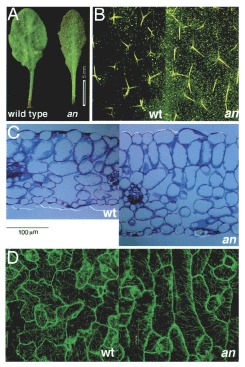From: A New Member of the CtBP/BARS Family from Plants: Angustifolia

NCBI Bookshelf. A service of the National Library of Medicine, National Institutes of Health.

Morphological phenotypes of the angustifolia (an) mutant of arabidopsis. A) Gross morphology of leaves of the wild type and an mutant. Note the narrow shape of the an leaf. Bar, 5 mm. B) Trichomes on the leaf. Wild-type trichomes are three-branched in most cases (left), whereas an trichomes are two-branched. The longitudinal direction of the panel corresponds to the leaf-length direction. C) Cross-section of leaves of the wild type (left) and an mutant (right). Note the narrow, longer shape (in the leaf-thickness direction) of the an leaf cells. Bar, 100 μm. D) Arrangement of cortical microtubules (MTs) in leaf epidermal cells. The longitudinal direction of the panel corresponds to the leaf-length direction. Compared with wild-type MTs, the an MTs are arranged more simply and parallel to the leaf-width direction. Modified from Kim et al.6
From: A New Member of the CtBP/BARS Family from Plants: Angustifolia

NCBI Bookshelf. A service of the National Library of Medicine, National Institutes of Health.